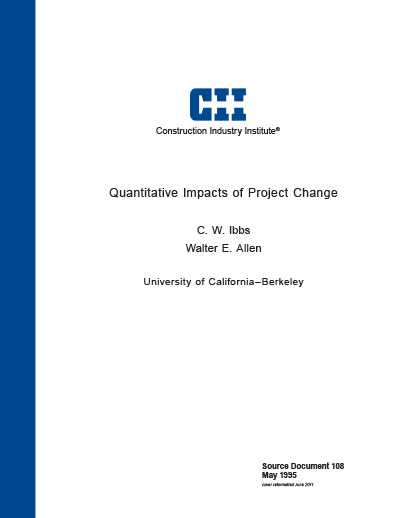
Quantitative Impacts of Project Change
The goal of this research study was to quantify the impact that changes have on engineering and construction project performance. Using previous CII studies and reports as a starting point, we developed and tested a series of hypotheses about those impacts. We were particularly concerned with identifying reliable, quantitative relationships between the amount and timing of change and the consequences of such change. This report presents our findings.
- Our first research hypothesis was that:
Changes that occur late in a project are implemented less efficiently than changes that occur early.
We were not able to prove this hypothesis to a meaningful level of statistical significance, though we did find and do report in this summary linear relationships between the amount of change and its timing.
- The second hypothesis of our study was that:
The more change there is on a project, the more of a negative impact it has on labor productivity.
We were able to prove this relationship in a variety of ways to the 5% and 10% levels of statistical significance.
- The third hypothesis was that:
The hidden or unforeseeable costs of change increases with more project change.
We were to prove this relationship in a variety of ways to the 5% and 10% levels of statistical significance.
In each case, linear regression models are presented in this report to allow the reader to make general comparisons between specific project experience and that of the 104 projects analyzed in this study.
In addition, we were able to extend our analysis in other directions. For instance, the amounts of change for these projects are reported for the engineering phase, construction phase and total project duration. The rate at which change accumulates over the duration of a typical project is illustrated, as are quantitative results for contingency usage. The amount of project change is compared to the degree of design-construction phasing or overlap. Finally, families of curves are reported which represent the probabilities of late completion or budget overrun, given late or early conditions at the 25% and 75% complete project status.
Based on these findings we offer recommendations to project managers for improving their management of change.
Naturally, each design and construction project has its own special characteristics. The results reported in this document therefore cannot be used blindly or arbitrarily. However, these results do represent a step forward in understanding how change occurs and affects projects. Many more questions remain to be studied and learned. This particular report provides a benchmark for future studies, both in terms of quantitative relationships that have already been scientifically confirmed and in terms of research methodologies.


